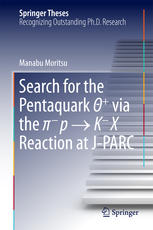

Most ebook files are in PDF format, so you can easily read them using various software such as Foxit Reader or directly on the Google Chrome browser.
Some ebook files are released by publishers in other formats such as .awz, .mobi, .epub, .fb2, etc. You may need to install specific software to read these formats on mobile/PC, such as Calibre.
Please read the tutorial at this link: https://ebookbell.com/faq
We offer FREE conversion to the popular formats you request; however, this may take some time. Therefore, right after payment, please email us, and we will try to provide the service as quickly as possible.
For some exceptional file formats or broken links (if any), please refrain from opening any disputes. Instead, email us first, and we will try to assist within a maximum of 6 hours.
EbookBell Team

4.3
68 reviewsThis theses reports on an experimental search for an exotic hadron, Θ+(1540) pentaquark, which is a genuine exotic hadron with a five-quark system of uuddsbar. The results of this book support that the existence of Θ+ was strongly constrained.
The Θ+ pentaquark was searched for via the π- p → K- X reaction using a beam momentum of 2.01 GeV/c at the J-PARC hadron experimental facility, taking advantage of high-statistics and high-resolution compared with previous experiments, some of which claimed the evidence of Θ+. In order to realize a good missing-mass resolution of 2 MeV, the beam spectrometer and superconducting kaon spectrometer were constructed.
No clear peak was observed in the missing mass spectrum of the π- p → K- X reaction, and the upper limit of the production cross section was found to be less than 0.28 μb/sr at the 90% confidence level in a mass region of 1500–1560 MeV/c2. This upper limit is an order of magnitude smaller than that of the previous KEK experiment. Compared with a theoretical calculation using the effective Lagrangian approach, the decay width of Θ+ was evaluated. The upper limits on the decay width were estimated to be 0.36 and 1.9 MeV for the Θ+ spin-parity of 1/2+ and 1/2-, respectively. These are quite small for a width of ordinary hadron resonances, and the existence of Θ+ was strongly constrained and is doubtful.